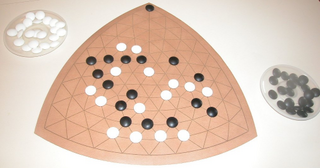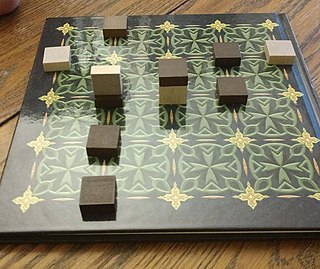
Gomoku, also called Five in a Row, is an abstract strategy board game. It is traditionally played with Go pieces on a Go board. It is played using a 15×15 board while in the past a 19×19 board was standard. Because pieces are typically not moved or removed from the board, gomoku may also be played as a paper-and-pencil game. The game is known in several countries under different names.

Pente is an abstract strategy board game for two or more players, created in 1977 by Gary Gabrel. A member of the m,n,k game family, Pente stands out for its custodial capture mechanic, which allows players to "sandwich" pairs of stones and capture them by flanking them on either side. This changes the overall tactical assessments players face when compared to pure placement m,n,k games such as Gomoku.

Hex is a two player abstract strategy board game in which players attempt to connect opposite sides of a rhombus-shaped board made of hexagonal cells. Hex was invented by mathematician and poet Piet Hein in 1942 and later rediscovered and popularized by John Nash.
A solved game is a game whose outcome can be correctly predicted from any position, assuming that both players play perfectly. This concept is usually applied to abstract strategy games, and especially to games with full information and no element of chance; solving such a game may use combinatorial game theory and/or computer assistance.

The rules of Go have seen some variation over time and from place to place. This article discusses those sets of rules broadly similar to the ones currently in use in East Asia. Even among these, there is a degree of variation.

Within most systems and at most levels in the game of Go, a handicap is given to offset the strength difference between players of different ranks.

Havannah is a two-player abstract strategy board game invented by Christian Freeling. It belongs to the family of games commonly called connection games; its relatives include Hex and TwixT. Havannah has "a sophisticated and varied strategy" and is best played on a base-10 hexagonal board, 10 hex cells to a side.

Y is an abstract strategy board game, first described by John Milnor in the early 1950s. The game was independently invented in 1953 by Craige Schensted and Charles Titus. It is a member of the connection game family inhabited by Hex, Havannah, TwixT, and others; it is also an early member in a long line of games Schensted has developed, each game more complex but also more generalized.

TwixT is a two-player strategy board game, an early entrant in the 1960s 3M bookshelf game series. It became one of the most popular and enduring games in the series. It is a connection game where players alternate turns placing pegs and links on a pegboard in an attempt to link their opposite sides. While TwixT itself is simple, the game also requires strategy, so young children can play it, but it also appeals to adults. The game has been discontinued except in Germany and Japan.
In combinatorial game theory, the strategy-stealing argument is a general argument that shows, for many two-player games, that the second player cannot have a guaranteed winning strategy. The strategy-stealing argument applies to any symmetric game in which an extra move can never be a disadvantage.

Chapayev is a board game, a hybrid of checkers (draughts) and gamepiece-impact games like carrom, novuss, and pichenotte, giving it gameplay aspects in common with both billiards and table shuffleboard on a smaller scale, as well as some checkers strategy. It is played throughout the territory of the former USSR. The aim is to knock the opponent's pieces off the board. The game is named after the Russian Civil War hero, Vasily Chapayev.
Komi (コミ) in the game of Go are points added to the score of the player with the white stones as compensation for playing second. The value of Black's first-move advantage is generally considered to be between 5 and 7 points by the end of the game.
Star is a two-player abstract strategy board game developed by Craige Schensted. It was first published in the September 1983 issue of Games magazine. It is a connection game similar to Hex, Y, Havannah, and TwixT. Unlike these games, however, the result is based on a player having a higher final score rather than achieving a specific goal. He has since developed a slightly more complicated version called *Star with better balance between edge and center moves, writing "*Star is what those other games wanted to be."
Hive is a bug-themed tabletop abstract strategy game, designed by John Yianni and published in 2001 by Gen42 Games. The object of Hive is to capture the opponent's queen bee by allowing it to become completely surrounded by other pieces, while avoiding the capture of one's own queen. Hive shares elements of both tile-based games and board games. It differs from other tile-based games in that the tiles, once placed, can then be moved to other positions according to various rules, much like chess pieces.
A connection game is a type of abstract strategy game in which players attempt to complete a specific type of connection with their pieces. This could involve forming a path between two or more endpoints, completing a closed loop, or connecting all of one's pieces so they are adjacent to each other. Connection games typically have simple rules, but complex strategies. They have minimal components and may be played as board games, computer games, or even paper-and-pencil games.

Onyx is a two-player abstract strategy board game invented by Larry Back in 1995. The game features a rule for performing captures, making Onyx unique among connection games.
This page explains commonly used terms in board games in alphabetical order. For a list of board games, see List of board games. For terms specific to chess, see Glossary of chess. For terms related to chess problems, see Glossary of chess problems.

Diamond is a two-player abstract strategy board game invented by Larry Back. The invention was inspired by the game Kensington, which uses a similar board pattern and game objective. Rules for Diamond were conceived in 1985 and finalized in 1994. Diamond introduces a new board geometry and neutral pieces, with the aim of enhancing the game dynamic and lowering the potential for draws.

Tak is a two-player abstract strategy game designed by James Ernest and Patrick Rothfuss and published by Cheapass Games in 2016.











